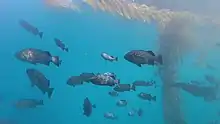Blue rockfish
The blue rockfish (Sebastes mystinus) or blue seaperch, is a species of rockfish of the northeastern Pacific Ocean, ranging from northern Baja California to central Oregon.[1]
| Blue rockfish | |
|---|---|
 | |
| Sebastes mystinus | |
| Scientific classification | |
| Kingdom: | Animalia |
| Phylum: | Chordata |
| Class: | Actinopterygii |
| Order: | Scorpaeniformes |
| Family: | Sebastidae |
| Genus: | Sebastes |
| Species: | S. mystinus |
| Binomial name | |
| Sebastes mystinus (D. S. Jordan & C. H. Gilbert, 1881) | |
Etymology
The species epithet mystinus derives from the Greek for "priest", referring to the overall dark color.
Description

Blue rockfish have a relatively smooth and oval appearance compared to other members of Sebastes, with very few head spines. Color is a bluish black to gray, with some darker mottling, including a pair of stripes angling down and back from the eye. The terminal mouths are small for rockfish. Length ranges up to 55 to 60 cm, and weights up to 3.8 kg.
Ecology
The main diet of the species is plankton. Juveniles consume tiny crustacea such as copepods and barnacle larvae (in some cases having a significant effect on the population), while adults shift to larger types, such as free-swimming tunicates, jellyfish, gastropods, squids, young rockfish, and drifting plant fragments.
Distribution
Blue rockfish occur from northern Baja California to central Oregon. Previous records further north are due to confusion with the deacon rockfish (S. diaconus), which only was scientifically described in 2015.[1]
While they have been caught at depths of over 500 m, most live near to the surface, down to 90 m.
Genetics
A potential PCR-RFLP genetic sex marker developed for gopher rockfish[2] does not successfully distinguish male and female blue rockfish.[3]
Fishing and management
Blue rockfish were once an important part of the California fishery; they were the most common rockfish marketed in San Francisco and San Diego during the 19th century, but have since declined in popularity. They continue to be of interest as game fish, and are among the most common types landed by boat anglers; in fact, there is evidence of overfishing in Monterey Bay and southern California.
References
- Frable, B.W., Wagman, D.W., Frierson, T.N., Aguilar, A. & Sidlauskas, B.L. (2015). "A new species of Sebastes (Scorpaeniformes: Sebastidae) from the northeastern Pacific, with a redescription of the blue rockfish, S. mystinus (Jordan and Gilbert, 1881)". Fishery Bulletin. 113 (4): 355–377. doi:10.7755/fb.113.4.1.CS1 maint: uses authors parameter (link)
- Fowler, Benjamin L.S.; Buonaccorsi, Vincent P. (2016). "Genomic characterization of sex‐identification markers in Sebastes carnatus and Sebastes chrysomelas rockfishes". Molecular Ecology. 25 (10): 2165–2175. doi:10.1111/mec.13594.
- Vaux, Felix; Aycock, Hannah M.; Bohn, Sandra; Rasmuson, Leif K.; O'Malley, Kathleen G. (2020). "Sex identification PCR–RFLP assay tested in eight species of Sebastes rockfish". Conservation Genetics Resources. 12: 541–544. doi:10.1007/s12686-020-01150-y.
- "Sebastes mystinus". Integrated Taxonomic Information System. Retrieved 11 March 2006.
Further reading
- Milton S. Love, Mary Yoklavich, Lyman K. Thorsteinson, (2002), The Rockfishes of the Northeast Pacific, University of California Press, pp. 215–218
- Froese, Rainer and Pauly, Daniel, eds. (2006). "Sebastes mystinus" in FishBase. February 2006 version.
| Wikispecies has information related to Sebastes mystinus. |
| Wikimedia Commons has media related to Sebastes mystinus. |